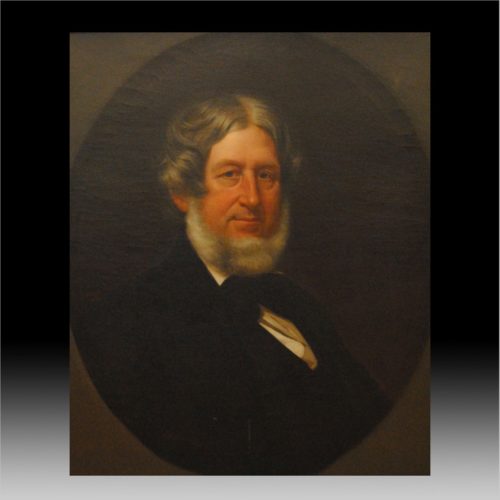-
John George Brown 1831-1913 Portrait of a Man Oil on canvas 25” x 30” John George Brown (November 11, 1831 – February 8, 1913) was a British citizen and an American painter born in Durham, England on November 11, 1831. His parents apprenticed him to the career of glass worker at the age of fourteen in an attempt to dissuade him from pursuing painting. He studied nights at the School of Design in Newcastle-on-Tyne while working as a glass cutter there between 1849 and 1852 and evenings at the Trustees Academy in Edinburgh while working at the Holyrood Glass Works between 1852 and 1853. After moving to New York City in 1853, he studied with Thomas Seir Cummings at the National Academy of Design where he was elected a National Academician in 1861. Brown was the Academy's vice-president from 1899 to 1904. Around 1855, he worked for the owner of the Brooklyn Glass Company, and later he married the daughter of his employer. His father-in-law encouraged his artistic abilities, supporting him financially, letting Brown pursue painting full-time. In 1866, he became one of the charter members of the Water-Color Society, of which he was president from 1887 to 1904. Brown became famous for his depictions of street urchins found on the streets of New York (bootblacks, street musicians, posy sellers, newsboys, etc.). @AC-NB
-
Jules Dupre (French, 1811-1889) ”Sailing Ships on Choppy Seas” Oil on Canvas 15”x 18 ” Signed lower left
-
John Ferneley Jr. (British, 1815-1862) In Search of the Hunt Signed and dated ‘John Fernely Jr./ 1849’ lower right. Oil on canvas. 17 x 22 in. (43.2 x 56 cm)
-
Studio of Martin Drolling (French, 1752-1817) “A Kitchen Interior with a Mother and Daughter Sewing and Another child Playing with a Kitten” Oil on canvas 25 ¼” x 31 ½” PROVENANCE: W. Scott & Sons, MontrealAC15384 (AC from artnet: sold price on 12/14/98) @AC-Bdwy
-
A Restored Ormolu Mantel Clock, Second Quarter 19th Century. The circular dial is with Roman numeral characters. Signed, “Le Roy hr. du Roi Palais Royal a Paris.” Height: 12 ¼ inches. CMR1496-2-17 AC6440
-
American School “Portrait of Gentleman”- Estate of Lincoln Isham Oil on canvas 25” x 30” Provenance: Park Bernet 3/30/72 @AC-NB
-
Maurice de Vlaminck ( French, 1876-1958) “L’entrée Du Village” Oil on canvas 23 ½”x 28 ½” Signed lower right COA by G. Petrides
-
William Holyoake (British, 1834-1893) "A Day at the Races" Oil on canvas 24 x 20 inches (61 x 51cm)
-
Antonio Allegri, il Coreggio “Venus, Cupid and a Satyr” Oil on Canvas 32” x 21 ½” (81.3 x 54.7 cm) CL102794-126 564601-2 @Albertson (5/19/03)
-
George Romney 1734-1802, British “Portrait of Emma Hart, Lady Hamilton, As Mirth” Oil in canvas 56 ½” x 45 ½” 143 X 115 cm Provenance: J.C. Curwen, M.P., Workington Hall, Cumberland, by whom acquired from the artist 1st Earl of Lichfield, Orgreave hall, Lichfield Thomas Challoner, Chester, (Sale: Christie’s, London, July 10, 1897) there purchased by Thos. Agnew and Sons, Ltd., London Duven Bros, New York, by 1929 until at least 1933 C.J. Wertheimer E.G. Raphael S101091-131 1667501-3 @AC-NB 1040 2/14
-
A Gilt Bronze and Porcelain Mantel Clock, circa 1860. The white enamel dial signed RAINGO Fres A PARIS, the movement with bell strike, the case with matt and burnished gilding possibly by Henri Picard, not stamped SO 102802-198 AC29600 F-1247
















